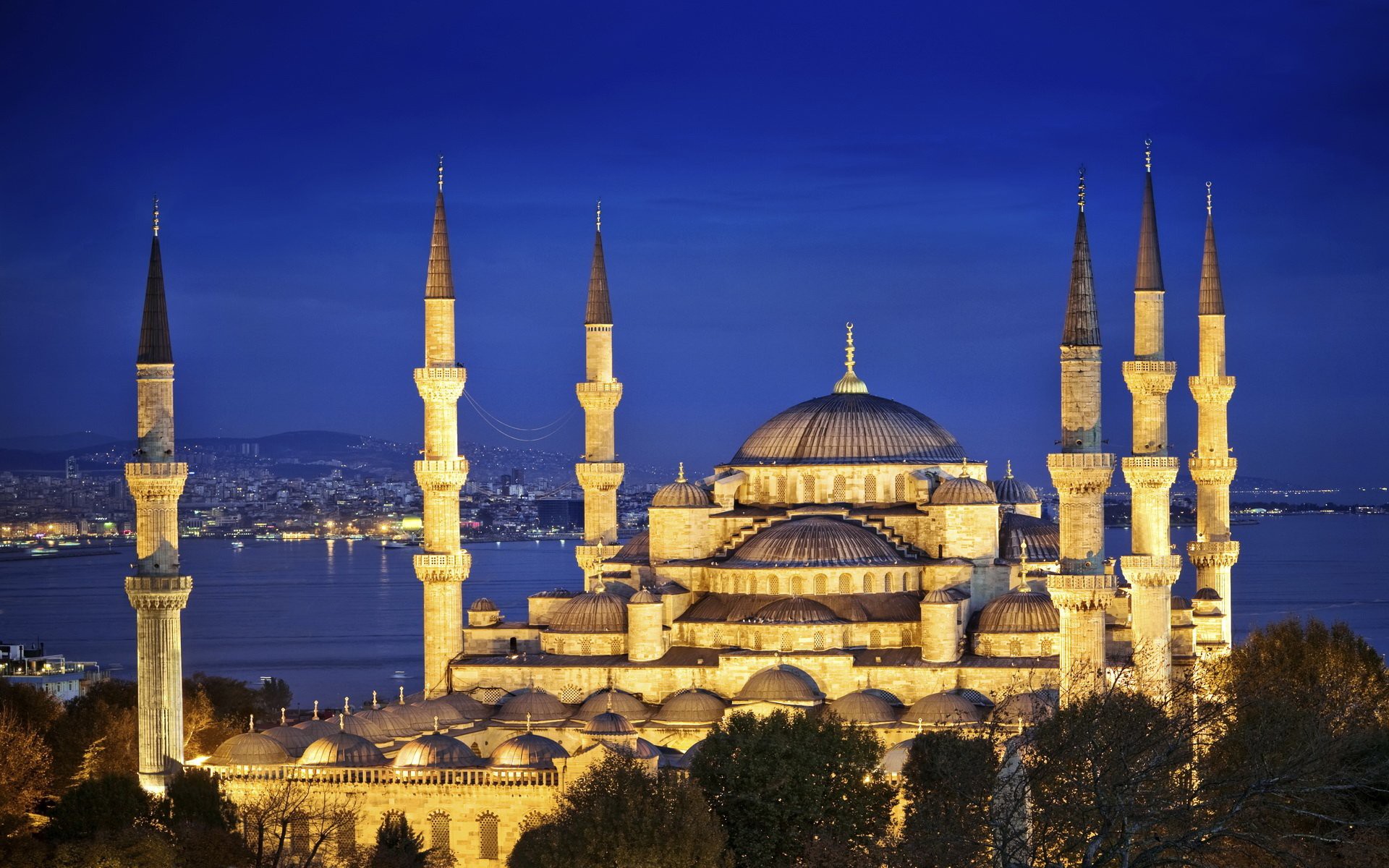
15 Top-Rated Tourist Attractions in Turkey
Packed to the brim with ancient monuments left over from a parade of empires, and endowed with showcase scenery that never fails to impress, Turkey is a dazzling destination that straddles Asia and Europe.
Its vibrant culture, famous food, and vast history wow all who venture here, while its glorious landscapes, from the sun-soaked Mediterranean to the mighty mountains and arid steppe, are tourist attractions in themselves.
1. Hagia Sophia (Aya Sofya) Mosque:
Renowned as one of the most beautiful buildings in the world, the spellbinding Byzantine glory of the Hagia Sophia Mosque (Aya Sofya) is not only one of the top things to do in Istanbul, but also in Turkey.Built by the Byzantine Emperor Justinian in 537 CE, it is renowned as the Byzantine Empire's greatest architectural achievement and has remained the world's largest church for 1,000 years.
The staggering bulk of its exterior is rimmed by the delicate minarets added after the Ottoman conquest, while the sumptuous and cavernous frescoed interior is a grand reminder of old Constantinople's might and power.
This famed monument is a must-do for every tourist visiting the country.

2. Ephesus:
Not to be missed, the mighty ruin of Ephesus is a city of colossal monuments and marble-columned roads.One of the most complete, still-standing famed cities of antiquity in the Mediterranean region, this is the place to experience what life must have been like during the golden age of the Roman Empire.
The city's history dates back to the 10th century BCE, but the major monuments you see today all date from its Roman era when it was a thriving commercial center.
In particular, the Library of Celsus, the complex of frescoed terraced houses, and the Great Theater all point to the wealth and importance of Ephesus during the Roman period.

3. Cappadocia:
The surreal, swooping rock valleys of Cappadocia are every photographer's dream.
Cliff ridges and hill crests are home to rippling panoramas of wave-like rock or wacky-shaped pinnacles that have been formed by millennia of wind and water action.
And if you don't feel like hiking for the views, this is one of the world's top destinations to take a hot-air balloon ride.
Nestled in this unique lunar-like landscape are the frescoed rock-cut churches and cave-cut architecture of the Byzantine Era, when this area was home to monastic Christian communities.
In particular, the multiple cave-churches of Göreme Open-Air Museum and Ihlara Valley are home to some of the best examples of surviving mid-Byzantine-era religious art in the world.
Cappadocia's villages, half hewn into the hillsides, where travelers base themselves to explore the surrounding countryside, are also an attraction in themselves, with their boutique hotels that allow you to bed down in a cave with full contemporary comforts.
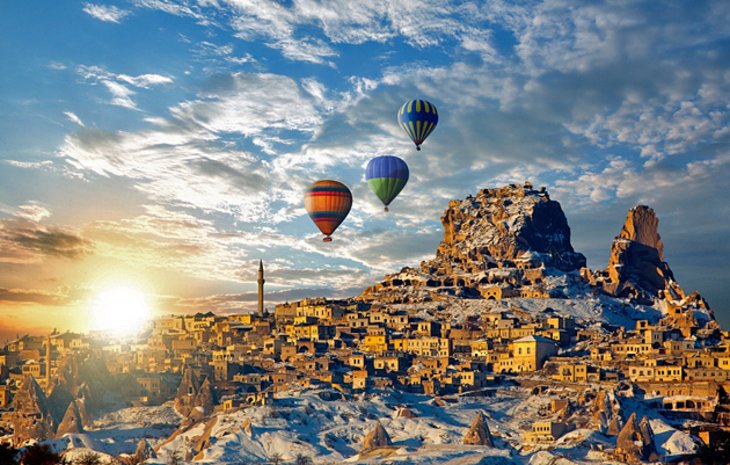
4. Topkapı Palace:
Sumptuous beyond belief, Istanbul's Topkapı Palace takes you into the fantastical, opulent world of the Sultans.
It was from here, during the 15th and 16th centuries, that the sultans of the Ottoman era carved out an empire that would extend up into Europe and down through the Middle East and into Africa.
The interiors, with their decadently exuberant tiling and lavish jeweled decor, are an unforgettable peek into the Ottoman's power base.
In particular, don't miss the Imperial Council building, where the empire's business was conducted by the Grand Vizier; the arms collection displayed in the Imperial Treasury; the world-class collection of miniature paintings; and the dazzling Harem rooms, which were designed by the famed Ottoman architect Sinan.

5. Pamukkale:
One of Turkey's most famous natural wonders, the pure white travertine terraces of Pamukkale ("Cotton Castle" in English) cascade down the slope looking like an out-of-place snowfield amid the green landscape.
Although the travertines are themselves a highlight of a Turkey trip, the vast and rambling ruins of Greco-Roman Hierapolis, an ancient spa town, lie scattered across the summit of this calcite hill.
After exploring the ancient theater, with its views across the countryside, and the remnants of the city's agora, gymnasium, necropolis, and grand gates, you can swim in the mineral-rich waters which made this ancient spa town famous, in the antique pool.
Afterward, walk down the travertine hill, wading through the pools of water in the upper terraces, to the small modern village of Pamukkale below.

6. Antalya:
This bustling Mediterranean hub has something for everyone.
The two main beaches outside of town are sun-sloth heaven in summer and attract holidaymakers from across Europe. While the old town area, snug right in the center of town, with its cobblestone alleyways rimmed by creaky Ottoman-era mansions, is a wonderful place to explore.
The Antalya Museum is renowned as one of the country's best, with an astonishing collection of Hellenistic and Roman marble statuary, and there are bags of attractions outside of town for travelers who want to use Antalya as a base.
In particular, Antalya is an easy base for day trips to some of Turkey's most famous Greco-Roman ruins, including Aspendos and Perge, which are just outside the city, and the town of Side, with its glut of ruins.
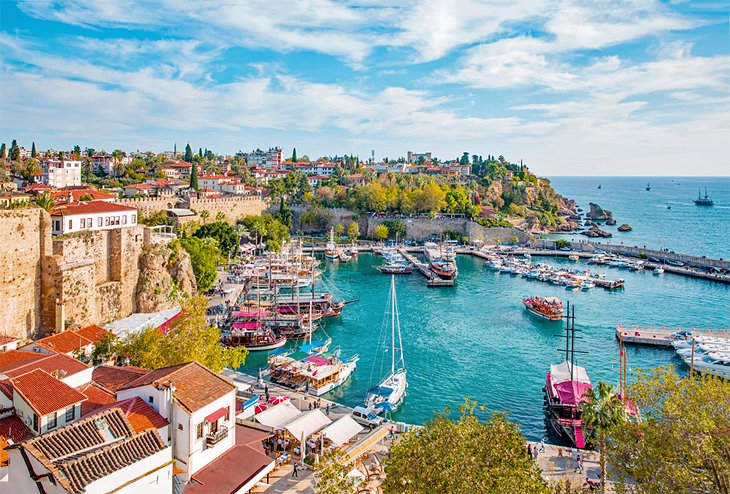
7. Aspendos:
Just south of the resort city of Antalya, the jaw-dropping mammoth bulk of the Roman Theater of Aspendos celebrates the pomp and ceremony of Marcus Aurelius' rule.
Considered the finest surviving example of a classical age theater still standing in the world, the highly restored, 15,000-seat theater is one of antiquity's star attractions.
Although the theater is the main reason for a visit here (and for most visitors on a half-day trip from nearby Antalya or Side, the theater is all they see) the Aspendos site offers plenty more ruins to explore.
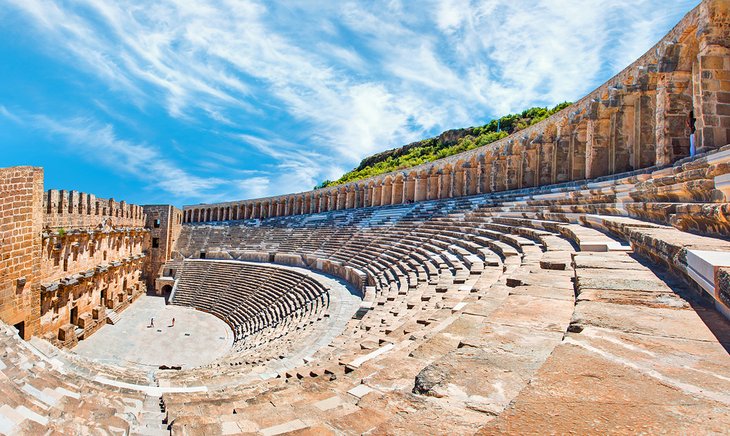
8. Pergamum:
Turkey has an abundance of Greco-Roman ruins, but none can be so romantically placed as ancient Pergamum in modern-day Bergama.
Once home to one of the ancient world's most important libraries (which rivaled Alexandria's library in prominence) and home to the famed medical school run by Galen, Pergamum's remaining temple remnants now preside dramatically across a hilltop.
It's an incredibly atmospheric place to explore. The Acropolis area with its theater cut into the hillside holds the most remains and offers sweeping panoramic views across the countryside.
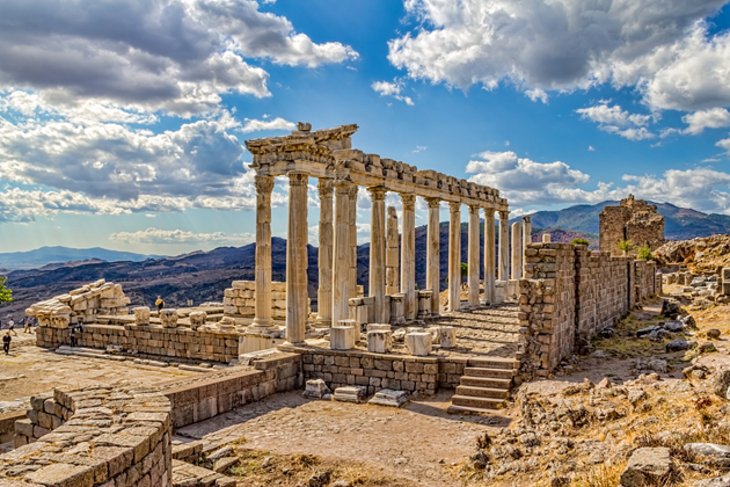
9. The Blue Mosque:
This famous mosque (officially called the Sultanahmet Mosque), facing the Hagia Sophia Mosque across Sultanahmet Park in Istanbul, is one of Turkey's most visited monuments.
Built by Sultan Ahmed I, the mosque was designed to mimic the Hagia Sophia by the architect Sedefkar Mehmet Ağa, a disciple of the Ottoman era's most renowned architect, Sinan.
With six slender minarets and a sprawling courtyard complex, everything about the Blue Mosque is on a grand scale but it's best known for its prayer hall interior covered in tens of thousands of blue Iznik tiles (for which the mosque gained its moniker), lit by shards of light from 260 windows.

10. Troy:
One of Turkey's most well-known ancient ruins, this site is thought by many to be the Troy of Homer's Iliad.
Whether it is, or not, the Troy of the Trojan War myths, the multi-layered, rambling ruins here expose a vast history of occupation, abandonment, and reoccupation that stretches right back to the early Bronze Age.
The ruins include well-preserved city walls and fortifications, the remnants of a palace, megarons (Mycenean hall complexes) and houses, along with later Roman-era sanctuary and Odeon monuments.

11. The Bosphorus:
One of the world's great waterways, the Bosphorus Strait separates Europe from Asia and connects the Black Sea with the Sea of Marmara (and hence, out to the Mediterranean).
Cruising along the Bosphorus, whether by hopping local ferries, on a tourist ferry cruise, or a private boat, is one of the great tourist attractions of an Istanbul stay. This is the most relaxing sightseeing opportunity in Istanbul.
Onboard, it's all about soaking up the scenery from the water, with the shorefront lined with Ottoman palaces; villas; and wooden mansions out to Rumeli Fortress, built by Mehmet the Conqueror; and (farther north along the strait), the Byzantine-era ramparts of Anadolu Fortress.
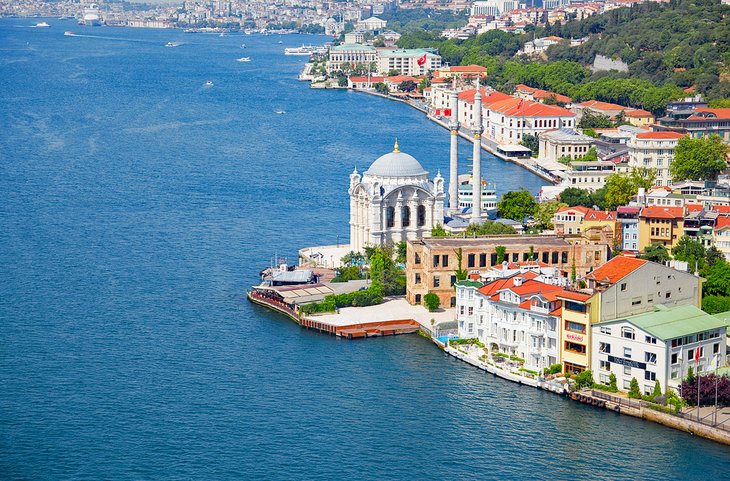
12. Sumela Monastery:
With its stunning, lonely setting, built into a cliff face, Sumela Monastery (Monastery of the Virgin Mary) is the star attraction for visitors along the Black Sea Coast.
Wandering around this abandoned religious complex, with its church interiors crammed with dazzling and vibrant frescoes, is a must for anyone who makes the long journey to Turkey's northeast region.
The monastery first opened during the Byzantine era and only ceased operation as a working religious center in 1923, when the monks were forced to leave as part of the Greek-Turkish Population Exchange.

13. Mount Nemrut:
The top sightseeing drawcard for eastern Turkey, Mount Nemrut's summit funerary mound is scattered with the broken remnants of once mammoth statues, which guarded it.
This weird and lonely place has to be one of Turkey's most peculiar archaeological sites. The giant stone heads of long-forgotten gods stare out from the summit, casting an eerie atmosphere over the barren mountaintop.
The summit's building works are the work of Antiochus I, ruler of the Commagene Kingdom, which lay here in the buffer region between the Roman and Parthian empires.
Antiochus I dedicated this grand funerary mound to himself as a showcase of his importance, raising a 50-meter-high artificial peak on Mount Nemrut's summit and then decorating it with statues of himself and various gods.
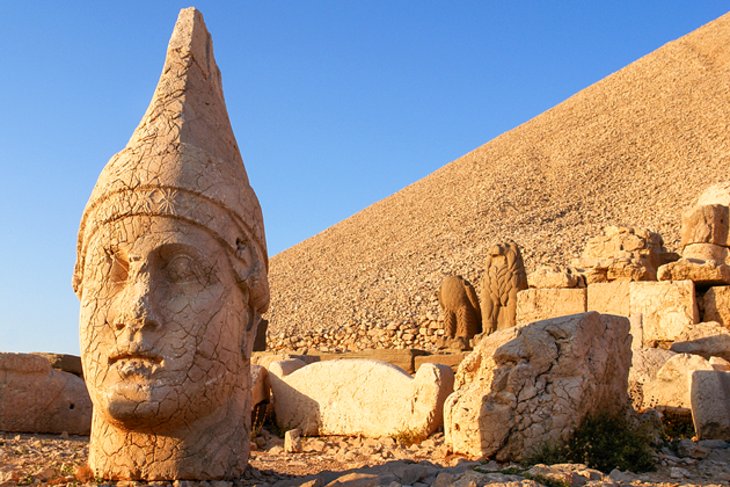
14. Basilica Cistern:
Why it’s awesome: The Basilica Cistern is the biggest ancient subterranean cistern beneath Istanbul’s teeming streets. Constructed during the 6th century, it was used to provide water for the city’s palace and other important buildings. It covers around 9,800 square metres (105,000 square feet). Although it can hold a huge volume of water, just a small amount covers the floor today. The ceiling is supported by grand columns, a few of which have ancient carvings, and the roof has arches and cross-shaped vaults. It is atmospheric, photogenic, and slightly spooky!

15. Taksim Square:
Why it’s awesome: Taksim Square is a bustling and lively part of Istanbul. Often referred to as the heart of modern Istanbul, it’s popular with both locals and tourists alike. There are many great Airbnb’s dotted around the area as well as a wealth of shops, restaurants, and bars. It’s also a significant transportation hub and home to a large cultural centre. The large square hosts many parades and celebrations, including a huge gathering on New Year’s Eve.




